smooth yellow violet
(Viola eriocarpa)
Conservation • Wetland • Description • Habitat • Ecology • Use • Distribution • Taxonomy
Description |
Smooth yellow violet rises on usually three or more stems. There are usually 1 to 4 basal leaves. The leaf blades are heart-shaped to broadly egg-shaped and have a heart-shaped base. The upper and lower leaf surfaces are hairless or sparsely hairy. The leaf blade has 8 to 15 teeth per side. The upper leaf stipules are semi-herbaceous, lance-shaped, and narrowly angled at the tip. The flowering stem is hairless or has hairs in longitudinal lines. |
Height |
4″ to 18″ |
Flower Color |
Yellow |
Similar Species |
Downy yellow violet (Viola pubescens) rises on one or two stems. There are usually no basal leaves, sometimes there is just a single basal leaf. The leaf blades are egg-shaped to kidney-shaped and have a broadly angled to straight (truncate) base. The upper and lower leaf surfaces are densely covered with minute, fine, short hairs, especially along the main veins. The leaf margin has 15 to 23 teeth per side. The upper leaf stipules are herbaceous, broadly egg-shaped, and broadly angled at the tip. The flowering stem is conspicuously hairy. Downy yellow violet is much less common in Minnesota. |
Habitat |
Dry. Woods, forests. |
Ecology |
Flowering |
April to June |
Pests and Diseases |
|
Use |
|
Distribution |
||
|
Sources |
|
| 5/8/2025 | ||
Nativity |
||
Native |
||
Occurrence |
||
Very common |
||
Taxonomy |
|
Kingdom |
|
Division |
Tracheophyta (Vascular Plants) |
Subdivision |
Spermatophytina (Seed Plants) |
Class |
|
Order |
Malpighiales (Nances, Willows, and Allies) |
Family |
Violaceae (violet) |
Subfamily |
Violoideae |
Tribe |
Violeae |
Genus |
Viola (violets) |
Subgenus |
Viola (pansies and violets) |
Section |
Chamaemelanium |
Subsection |
|
A survey of violets (Russel, 1965) argued that Viola pubescens and Viola eriocarpa intergraded wherever the two species occurred together. For this reason, he combined them as subspecies, and he renamed Viola eriocarpa to Viola pubescens var. eriocarpa. Following that publication, virtually all floras and treatments used the name Viola pubescens var. scabriuscula. Several treatments between 1995 and 2001 synonymized the two species as Viola pubescens. A recent taxonomic treatment of the genus Viola reviewed just the species occurring in northeastern North America, specifically those species included in the second edition of Gleason and Cronquist’s Manual of Vascular Plants of Northeastern United States and Adjacent Canada. Among the many changes suggested by the authors was separating Viola pubescens var. pubescens and Viola pubescens var. scabriuscula as distinct species. |
|
Subordinate Taxa |
|
|
|
Synonyms |
|
Crocion achlydophyllum Crocion scabriusculum Crocion scabriuscum Crocion scrabriusculum Viola achlydophylla Viola dasyneura Viola eriocarpa var. leiocarpa Viola eriocarpa var. sessilis Viola eriocarpa var. typica Viola eriocarpon var. leiocarpon Viola pensylvanica var. leiocarpa Viola pubescens var. eriocarpa Viola pubescens var. leiocarpa Viola pubescens var. leiocarpon Viola pubescens var. scabriuscula Viola scabriuscula |
|
Common Names |
|
downy yellow violet smooth yellow violet stemmed yellow violet |
|
Visitor Photos |
||
Share your photo of this plant. |
||
This button not working for you? |
||
Dan W. Andree |
||
Yellow / Yellow & White Violet... I seen a yellow violet plant with two all yellow flowers on it and one with white and yellow. Only seen one yellow violet plant that way. |
||
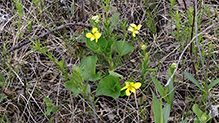 |
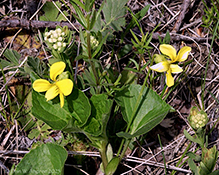 |
|
… This is that one yellow plant with the two all yellow and one a yellow and white mix blossoms. … This was the only yellow violet I seen on that area of the prairie. |
||
This is a little closer image just showing two of the flowers on that same yellow violet plant. |
||
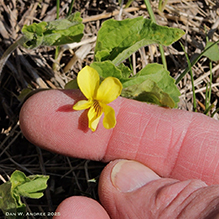 |
||
Another Smooth Yellow Violet... It’s a cute little plant and the ones I came across healthy looking too. |
||
Yellow Violet... I came across some yellow violets just starting to bloom. I noticed several plants but only one or two that had flowers a few had some buds with yellow just showing. No prairie violets yet, but I had never seen yellow violets until yesterday at Frenchman’s Bluff SNA. Only seen them in one area out there. |
||
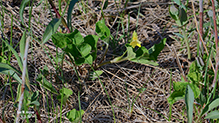 |
 |
|
Bill Reynolds |
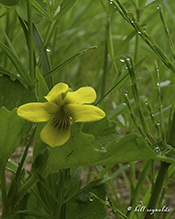 |
Smooth Yellow Violet |
MinnesotaSeasons.com Photos |
||
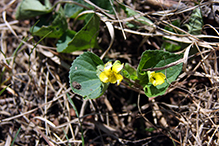 |
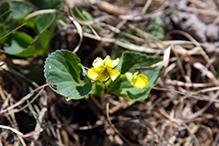 |
|
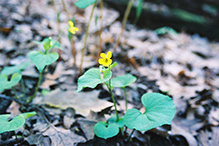 |

Slideshows |
|

Visitor Videos |
||
Share your video of this plant. |
||
This button not working for you? |
||
|
Other Videos |
||
MyNature Apps; Identifying Smooth Yellow Violet, Viola pensylvanica |
About
Uploaded on May 29, 2011 How to identify Smooth Yellow Violet, Viola pensylvanica, www.mynatureapps.com |
Yellow Violet (Viola pubescens eriocarpa) |
About
Published on Mar 24, 2012 Yellow Violet (Viola pubescens eriocarpa) |

Visitor Sightings |
||
Report a sighting of this plant. |
||
This button not working for you? |
||
Dan W. Andree |
I seen a yellow violet plant with two all yellow flowers on it and one with white and yellow. Only seen one yellow violet plant that way. I wondered if the two colored occurrence just an occasional thing? I will see if I got a clear image of it as it was windy when I seen it. |
|
John Valo |
I have seen “white” common blue violets, but never “white” yellow violets. I browsed the first two hundred or so photos of smooth yellow violet on iNaturalist.org, and none of them show white petals or even a partially white petal. Since you could not get a good photo due to the wind, the whiteness is not a photographic artifact. Two possibilities come to mind. First, the petal in question is somehow dying, damaged, or infected with a plant virus, and the white portion is a dead or damaged spot. Second, the open habitat and exposure to full sun may have caused the whiteness. Creating the yellow takes some plant energy. The plant may have prioritized a defensive strategy against burning under direct sunlight, taking energy away from producing petal color. This often happens with common blue violet grown in shady areas. In my yard, common blue violets are common, about half of the violets, in shady areas, and there are none in areas that get sun all day long. In Savage Fen SNA, under a dense oak/maple forest canopy, almost all common blue violets are white. |
|
| Dan W. Andree | I thought when I first seen that whitish area on that yellow violet maybe it was just a whiteout due to lighting in photography sometimes so I tried to adjust the camera settings to get rid of it but couldn’t. I got closer to the plant and realized it was white areas on the flower and not from sunlight etc. making it look white. I do have some images of it that does show the white area. This yellow violet was by itself in the NE section of Frenchman’s whereas the group of them quite a ways west. The flower wasn’t wilting and seemed to have some white on the underpart of the violet as well. The petals were just partly white in areas with the rest yellow. It was a fairly good sized plant compared to the group of them farther west (There were tons of them in that one area popping up). Last season in the area of this certain yellow violet there were many bergamot etc. plants. This plant looked really healthy. I am trying to find the clearest images. I shot video of it too and some turned out fine. It was breezy but nothing like yesterday or today up here. |
|
This is that one yellow plant with the two all yellow and one a yellow and white mix blossoms. I am still going through to see if I can get a closer image. I may have to take a frame grab off of some of the 4k footage. This was taken with a Canon f/1.8 50mm STM lens. Also the breeze never totally stopped I tried to block it. The lighting constantly changed from quick under clouds to open sunlight. One has to be aware this time of year for wood ticks too. I always keep that in mind and take real caution in that area. This was the only yellow violet I seen on that area of the prairie. But I was on my way out from also spending time on the far west burnt area checking things out. It is doing good so far. But here is one photo I have of that yellow and white one etc. |
 |
|
| John Valo | The misshapen and underdeveloped petals on that one flower strongly suggest a plant pathogen, with a virus being the most likely culprit. The fact that only one of the three flowering stems is affected, and the leaves appear healthy, hints that the issue might have been introduced by an insect feeding on that specific flower bud or newly opened bloom. While environmental stress is a possibility, the lack of any other symptoms on the plant makes that less probable. Genetic mutation (chimera) is unlikely because it would affect the entire flower or a consistent pattern within it. Herbicide injury is also unlikely in a managed prairie environment. |
|
| Dan W. Andree | … This is a little closer image just showing two of the flowers on that same yellow violet plant. |
 |
Dan W. Andree |
Location: Frenchman’s Bluff SNA It’s a cute little plant and the ones I came across healthy looking too. |
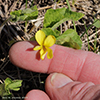 |
Dan W. Andree |
Location: Frenchman’s Bluff SNA I came across some yellow violets just starting to bloom. I noticed several plants but only one or two that had flowers a few had some buds with yellow just showing. No prairie violets yet, but I had never seen yellow violets until yesterday at Frenchman’s Bluff SNA. Only seen them in one area out there. |
 |
| Bill Reynolds 6/1/2014 |
Location: Pennington Co. MN |
 |
MinnesotaSeasons.com Sightings |
||

Created: 5/12/2006 Last Updated: © MinnesotaSeasons.com. All rights reserved. |
